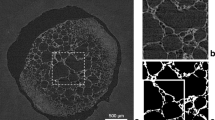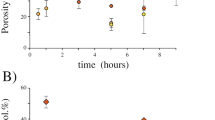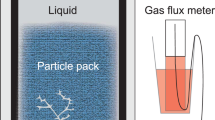Abstract
A series of experiments was conducted to test concepts of porous flow degassing of rhyolitic magma during ascent and of the subsequent collapse of vesicles in degassed magma to form obsidian. Dense, synthetically hydrated, natural glasses were pressurized under water-saturated conditions and then decompressed to achieve a range of porosities in the presence of a tracer vapor, D2O. Rapid isotopic exchange indicative of vapor transport rather than of simple diffusion occurred at a porosity >60 vol.%, in accord with earlier gas permeability measurements on cold natural samples. In another series of experiments, natural and synthetic pumices, vesiculated by degassing to atmospheric pressure, rapidly collapsed to dense glass on repressurization to the modest pressures prevailing in lava flows. No relict bubble textures remained. These results support the hypothesis that effusive eruptions result from the syneruptive escape of gas from permeable magmatic foam, and that a process analogous to welding yields dense lavas when such foams are extruded.
Similar content being viewed by others
References
Bence AE, Albee A (1968) Empirical correction factors for the clectron microanalysis of silicates and oxides. J Geol 76:382–403
Burnham CW (1979) The importance of volatile constituents. In: Yoder HSJ (ed) The evolution of the Igneous rocks. Princeton Univ Press, Princeton, pp 439–482
Carrigan CR, Eichelberger JC (1990) Zoning of magmas by viscosity in volcanic conduits. Nature 343:248–251
Chouet BA, Page RA, Stephens CD, Lahr JC, Power JA, Precursory swarms of long-period events at Redoubt Volcano (1989–1990), Alaska: Their origin and use as a forecasting tool. J Volcanol Geotherm Res, in press
Eichelberger JC (1989) Are extrusive rhyolites produced from permeable eruptions? A reply. Bull Volcanol 51:72–75
Eichelberger JC, Westrich HR (1981) Magmatic volatiles in explosive rhyolitic eruptions. Geophys Res Lett 8:757–760
Eichelberger JC, Carrigan CR, Westrich HR, Price RH (1986) Nonexplosive silicic volcanism. Nature 323:598–602
Endo ET, Dzurisin D, Swanson DA (1990) Geophysical and observational constraints for shallow ascent rates of dacitic magmas at Mount St. Helens. In: Ryan MP (ed) Magma Transport and Storage. Wiley, New York, pp 317–334
Fink JH, Anderson SW, Manley CR (1992) Textural constraints on effusive silicic volcanism: Beyond the permeable foam model. J Geophys Res 97:9073–9083
Friedman I (1989) Are extrusive rhyolites produced from permeable foam eruptions? Bull Volcanol 51:69–71
Hervig RL, Williams P (1988) SIMS microanalysis of minerals and glasses for H and D. In: Huber AM, Werner AW (eds) Secondary Ion Mass Spectrometry, SIMS IV. Wiley, New York, pp 961–964
Jaupart C, Allegre C (1991) Gas content, eruption rate and instabilities of eruption regime in silicic volcanoes. Earth Planet Sci Lett 102:413–429
Keenan JH, Keyes FG, Hill PG, Moore JG (1969) Steam Tables (SI Units). Thermodynamic Properties of Water Including Vapor, Liquid, and Solid Phases. Wiley, New York, 156 pp
Newman S, Epstein S, Stolper E (1988) Water, carbon dioxide, and hydrogen isotopes in glasses from the ca. 1340 A.D. eruption of the Mono Craters, California: Constraints on degassing phenomena and initial volatile content. J Volcanol Geotherm Res 35:75–96
Russ JC (1990) Computer-Assisted Microscopy. Plenum Press, New York, 453 pp
Rutherford MC, Hill PG (1993) Magma ascent rates from amphibole breakdown: An experimental study applied to the 1980–1986 Mount St. Helens eruptions. J Geophys Res 98:19667–19685
Rutherford MC, Devine JD (1988) The May 18, 1980 eruption of Mount St. Helens 3: Stability and chemistry of amphibole in the magma chamber. J Geophys Res 93:11949–11959
Scandone R, Malone SD (1985) Magma supply, magma discharge and readjustment of the feeding system of Mount St. Helens during 1980. J Volcanol Geotherm Res 23:239–262
Sparks RS (1978) The dynamics of bubble formation and growth in magmas: A review and analysis. J Volcanol Geotherm Res 3:1–37
Stasiuk MV, Jaupart C, Sparks S (1993) On the variations of flow rate in non-explosive lava eruptions. Earth Planet Sci Lett 114:505–516
Taylor BE, Eichelberger JC, Westrich HR (1983) Hydrogen isotopic evidence of rhyolitic magma degassing during shallow intrusion and eruption. Nature 306:541–545
Westrich HR (1987) Determination of water in volcanic glasses by Karl Fischer titration. Chem Geol 63:335–340
Westrich HR, Stockman HW, Eichelberger JC (1988) Degassing of rhyolitic magma during ascent and emplacement. J Geophys Res 93:6503–6511
Westrich HR, Eichelberger JC, Hervig RL (1991) Degassing of the 1912 Katmai magmas. Geophys Res Lett 18:1561–1564
Wilson L (1980) Relationships between pressure, volatile content and ejecta velocity in three types of volcanic explosions. J Volcanol Geotherm Res 8:297–313
Author information
Authors and Affiliations
Rights and permissions
About this article
Cite this article
Westrich, H.R., Eichelberger, J.C. Gas transport and bubble collapse in rhyolitic magma: an experimental approach. Bull Volcanol 56, 447–458 (1994). https://doi.org/10.1007/BF00302826
Received:
Accepted:
Issue Date:
DOI: https://doi.org/10.1007/BF00302826




